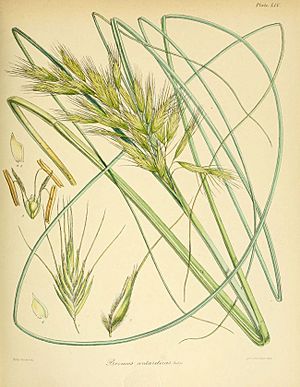Chionochloa antarctica facts for kids
Quick facts for kids Chionochloa antarctica |
|
|---|---|
 |
|
| Plate LIV (artist Fitch) | |
| Conservation status | |
|
Invalid status (NZ TCS)
|
|
| Scientific classification | |
| Genus: |
Chionochloa
|
| Species: |
antarctica
|
| Synonyms | |
|
Bromus antarcticus Hook.f. |
|
Chionochloa antarctica, often called snow tussock, is a special type of grass. It grows only on the Auckland and Campbell Islands, which are far south of New Zealand. This means it is endemic to these islands, found nowhere else in the world!
Contents
What is Snow Tussock?
Snow tussock is a large, clumpy grass. It grows in dense bunches, forming a tussock. These tussocks can be quite tall, sometimes reaching over a meter in height. They have long, narrow leaves that can be green or brownish.
This plant is well-adapted to the cold and windy conditions of its island home. It can handle the harsh weather, including strong winds and low temperatures.
Life Cycle of Snow Tussock
Snow tussock has a specific time of year when it grows and reproduces. It starts to flower from October to December. During this time, it produces small flowers that are often hidden within its leaves.
After flowering, the plant begins to produce seeds. This happens from November to March. These seeds help the snow tussock spread and grow new plants.
Why is Snow Tussock Important?
Snow tussock plays a key role in the ecosystems of the Auckland and Campbell Islands. It provides shelter and food for many native animals. Small birds and insects often live among the tussock clumps. It also helps to hold the soil together, preventing erosion from the strong winds and rain.
Protecting Snow Tussock
Because snow tussock only grows in a small area, it is considered "At Risk - Naturally Uncommon." This means it is not found in many places. The New Zealand Threat Classification System keeps an eye on plants like this.
In 2009, 2012, and again in 2018, experts confirmed its "At Risk" status. This is mainly because it has a very limited range. Protecting its island homes is important to make sure this unique grass continues to thrive for many years to come.

